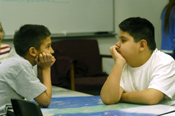|
Culture
clash
Can No Child Left Behind coexist with
Indian Education for All?
Story by: Caitlin
Copple
Photos by: Mary Rizos
Carol
Capps’ 7th graders bound into her pre-algebra class after
a morning of sweating over standardized test booklets, knowing
their performance will help determine the financial future
of their school.
Capps asks
them how they did, and responses are mostly negative, but in the giggly way of
teenagers with bigger things on their minds.
Several mention a question on the reading portion of the test about a Zamboni,
the machine used to groom ice rinks. No one in the class has heard of a
Zamboni, and Capps explains their use.
The scene
in Rocky Boy on the Rocky
Boy’s Reservation encapsulates
the conflict about the kind of citizens public schools are trying to create.
Debate over
testing, and specifically, the federal No
Child Left Behind policy
that requires it, is fierce on Rocky Boy’s Reservation, a 120,000-acre
reserve in northcentral Montana that is home to Chippewa and Cree.
Should students
know what a Zamboni is so they can perform well on a federal test, or is it more
important that schools teach them who they are and how to make life decisions?
In Montana,
the 1972 Constitution pledges that the state is committed, through education,
to the preservation of Indians’ cultural identity. Those were little more
than lofty words until the 2005 Legislature backed them with a $550,000 appropriation.
Now, off-reservation schools are adding it to the curriculum because it’s
the law. At Rocky Boy schools, it’s in the core of the curriculum
because it’s their life.
Federal
No Child Left Behind policy says
that knowledge is measurable by standardized tests. Critics say those tests reflect
more about children’s household income and their parents’ level of
education than about how much a student knows.
Bruce Patera,
a Caucasian junior and senior high school librarian at Rocky Boy, says it’s
obvious that standardized tests are geared toward white middle class America.
“Look
at the incoming vocabulary of a native student compared with a white,” he
says. “They come in with a different cultural viewpoint than other students. If
you’ve never seen a skyscraper, how do you know what adjective you should
use to describe it, or industrial pollution for that matter? I don’t
think the tests are meaningful.”
Educators
are divided between those who like No Child Left Behind for its scientific methods
and data-driven standards. Others feel standardized tests are a one-size-fits-all
Band-Aid for an education system reflective of America’s social problems
and economic inequalities. That, critics contend, explains why minority students,
including Native Americans, are consistently out-performed by their white peers.
In Montana,
American Indians are three times more likely to drop out of high school than
white students.
On tests that
determine whether a school meets the No Child Left Behind requirements, results
for the 2003-2004 school year show 38.4 percent of all Indian students made or
exceeded proficiency levels for reading. In math, 27.6 percent of students
met the standards. Grades 4, 8 and 10 were tested.
Some of Rocky
Boy’s schools fared worse. At the elementary level, 33.3 percent
of Indian students met or exceeded reading proficiency standards. Just 4.8 percent
of students achieved proficiency or higher on the math portion of the test.
At
the junior high, 28.2 percent of students were at or above proficient
in reading, with 35.9 percent in math. High school students
at the reservation scored less well, with 15.2 percent meeting
or exceeding proficient scores, and just 3 percent meeting proficiency
or higher in math.
1 2 3
View
the
Rocky Boy's Slideshow |
|

Two third graders in Cree class at Rocky
Boy Elementary School. |
